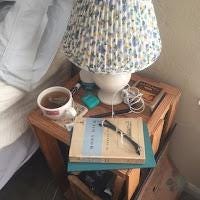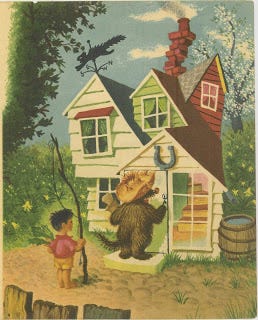The Look of a Book
I’ll admit, I judge books by their covers.
When I was five or six, I went through a period in which I would only check out Beatrix Potter’s books at the library. They were so cute, so tiny, with such pretty pictures, and they fit into the basket on my bike.
My mom was on to me. She encouraged me to mix it up and eventually I did, but Beatrix Potter got me reading.
* * *
When I bought the 1951,100th anniversary edition of Moby Dick, I rationalized the purchase by telling myself it's one of those classics that I should read. I taught American literature for gosh sakes. I should at least attempt it. Like Beatrix Potter’s books, this edition was small with a hint of blue on the cover. Surviving every purge, it moved with me to three different apartments. It was sparking too much joy to put it in the pile destined for Half Price Books.
Recently I took it from the shelf and started reading. It wasn't as bad as I thought it was going to be. I liked Ishmael, and then I really liked Queequeg. They were surprisingly relatable considering they were a whaler and a harpooner from the 19th century. Now I had an excuse to display it. I cleared the other books from my night stand, and I got a lot of pleasure from seeing it there. The shade of blue was my favorite, cauliflower blue. According to Reddit, that's the Mandela effect at work. Other people remember seeing cauliflower blue in their big box of Crayons, but we're all misremembering together. It’s cornflower blue, silly.
I'm on page 276 chapter 69, "The Squid." It's slow going. To borrow from Hawthorne it's of the "somniferous school of literature" or to flex my Word Power chops, quite soporific. It's been the prelude to more than one nap. But I'm doing it, by God, and I'm learning more about whaling than I’ll ever need to know. Corey has given me some Biblical reference books to help with the allusions, and San Antonio's Whitte Museum has been kind enough to run an exhibit on whales through September.It's a good thing it pleases me, because no one except Corey is ever in my bedroom to appreciate the scene I’ve staged on my nightstand. I’d trot it out in public, but I don't belong to a gym or ride a commuter train. There is no place where I could inconspicuously show it off. Plus it’s brittle and I need not shove it into my book bag and risk a leak from my water bottle or lunch.
I’m less concerned about people knowing I’m reading Moby Dick than the feeling that I’m wasting an accessory. Feels like hanging a Picasso in the closet. I’m not above wanting to be seen reading the right book. In high school I made a point of dropping my thick copy of Grapes of Wrath on my desktop in the hope that Ms. Slavens might realize she was wrong about my being a poor fit for honors English.
* * *
As I was writing my own book I imagined its cover. Right up there with my fear that it will never be published is another fear that my book will be published, but I’ll have to settle for a hideous cover.
Have you seen new book covers lately? On the new fiction table at Barnes and Noble or on the displays at airports, and in LASA’s school library where I sub, the covers seem to be AI generated. They have busy graphics. They’re too colorful, too vivid somehow. It’s like watching a Lifetime movie with my Mom on her high definition TV.
I went searching for examples of ugly book covers to illustrate my point and actually found some compelling covers (I put two in my Amazon cart) but below you’ll see what I’m talking about. (Sorry, Steven L. Fawcette, I will not be reading Arch Angels: The Grigori.)
*. *. *
Margaret Wise Brown is most famous for Runaway Bunny and Midnight Moon, but I prefer Mister Dog. When my first grandson was born I set out to buy him the same copy I’d had as a child with the story of Mister Dog on one side, and when you flipped the book over and turned it around you could read the story of Miss Kitty. I Googled it. Turns out there never was Miss Kitty on the flippity flop.
I thought I loved Mister Dog because of the illustrations of the cozy cottage where he lived with his boy. It became the template for every hay loft, club house, tent, bedroom, dorm room, classroom and apartment I’d go on to inhabit.
I wanted to jump in and live in the tiny crooked house. It was cozy. It was tidy like Mister Rogers’ house with a place for everything and everything in its place.
Crispins Crispian was a conservative. He liked
Everything at the right time–
Dinner at dinner time . . .’
Sunset at sunset,
And at bedtime, he liked everything in its own place–
The cup in the saucer,
The chair under the table,
The stars in the heavens,
The moon in the sky,
And himself in his own little bed.
And then what did he do?
Then he curled up in a warm little heap and went to sleep,
And he dreamed his own dreams.
That’s what the dog who belonged to himself did.
And what did the boy who belonged to himself do?
The boy who belonged to himself curled up in a warm
little heap and went to sleep and dreamed his own dreams.
That’s what the boy who belonged to himself did.
Though the look of this book reeled me in, it was the ideas that stuck. Belonging to oneself . . . that must have resonated with little me. Back then I had no concept of autonomy, but I suspect it’s why I imagined the equivalent universe for cats and girls. It got me dreaming my own dream.








